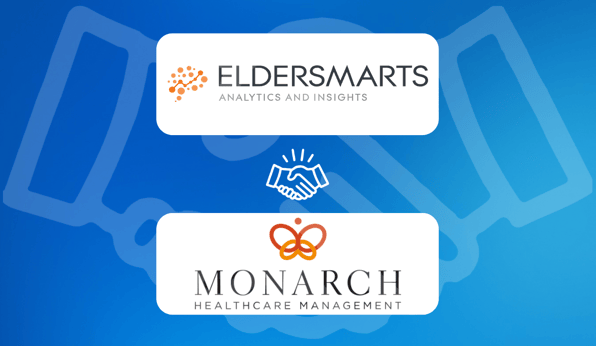Managing the Senior Living Staffing Shortage

The senior living staffing crisis is impacting nearly every assisted living, independent living, long-term care, and memory care organization in the country, and there are no signs of the tide turning anytime soon. In fact, a report from the American Health Care Association says that 99% of all skilled nursing organizations in the U.S. currently have job openings. And yet the same report also says many communities are turning residents away, and some fear they may face closure, especially in the wake of new federal mandates that will demand the addition of over 100,000 new caregivers and nearly $7 Billion in funding nationwide.
Most senior care communities report they have not recovered since the COVID-19 pandemic and have been scrambling to fill empty roles and meet staffing minimums for the last four years. We’ve reached a boiling point across the country, and unless drastic actions are taken, vital senior living communities will be shuttered for good, leaving tens of thousands of residents — or even more — in need of care.
If your community is working now to fight through the current staff shortage, we want you to know that we’re behind you. That’s why we’ve put together this guide on managing senior living staff shortages and optimizing recruitment and retention.
Understanding the Current Senior Living Staffing Shortages
So what does this workforce shortage mean to senior living communities? Let’s take a look at the impact, by the numbers, according to the American Health Care Association survey:
As of March 2024, over 70% of nursing homes say their staffing numbers are lower than they were before the pandemic.

A shocking 90% of skilled nursing communities admit that finding staff and filling roles comes with some degree of difficulty.

A disheartening 0% said it was very easy to fill staff roles.
That leaves many senior living communities turning to other measures to find adequate support.

New regulations from the federal government mean that already struggling providers will have an even greater burden, with more roles and hours to fill with skilled nurses, nursing aides, and support staff. Any way you look at it, the situation is dire. But how did we get to this point?
What Causes Staffing Challenges?
There is no single finger of blame to point for the recent staffing shortages among senior living communities. The reasons are many and varied, but we are able to narrow them down to a handful of prevalent reasons.
Pandemic Fallout
While it seems the worst of the COVID-19 pandemic is behind us, the repercussions of that time and the workforce crisis it spawned are still being felt most deeply in the realm of long-term care and skilled nursing. The trauma of that time resulted in an unbearable mental load for many employees, who reported feelings of exhaustion and burnout on a weekly or daily basis.

This burnout led to many workers looking for new jobs or new roles, while many others left the field entirely.
Increased Demand from an Aging Population
On the upside, people are living longer than ever before. The downside is that they are more likely to require senior care as they age, placing an even greater demand on an already-burdened system.

According to the World Health Organization (WHO), the portion of the global population over the age of 60 will have nearly doubled between 2015 and 2050, placing an even greater strain on assisted living communities, nursing homes, and senior living communities.
Nurses Nearing Retirement
The aging population impacts the caregiving community as well, with nearly 1 million nurses over the age of 50 and approaching retirement in the next 10-15 years.

This means that over a quarter of skilled nurses could be retiring soon, and there simply will not be enough incoming employees to replace them.
Education Gap
The reason there won’t be enough nurses coming in is at least partially to do with the education gap. Enrollment in nursing programs is at its lowest point in more than 20 years. Why? It’s not entirely due to a lack of interest on the part of incoming students. In fact, some students are being turned away from nursing programs because there simply isn’t enough faculty to teach them.

Like many senior living communities, educational institutions are struggling with recruitment and retention, meaning they have fewer faculty members.
Federal Mandates on Staffing Levels
There are changes ahead for many senior and assisted living communities. New federal regulations from the Centers for Medicare and Medicaid Services will increase staffing requirements for registered nurses and put shortages into even sharper focus. According to AHCA/NCAL, just 6% of nursing homes currently meet the requirements, and once they go into effect, many communities will be under intense pressure to ramp up their staff.
While the above data on staffing challenges details why recruitment has become so difficult for many senior living communities, there’s another major hurdle employers are facing: retention. Staff retention is an even bigger challenge in the era of the Great Resignation and quiet quitting, with nearly half of all workers actively seeking to switch employers. There are, however, numerous strategies for staff retention that can be leveraged to hold on to your top talent.
The Impact on Assisted Living and Senior Living Communities
The current state of senior living is unsustainable, and if the staffing crisis doesn’t turn around, the impact will be devastating. Here are some of the most significant anticipated effects:
- Decreased personal or one-on-one attention and care for residents
- Disruptions in continuity of care
- Lower satisfaction scores from residents and families
- Lapses in operational efficiency
- Disproportionate workload expected of fewer employees
- Shift to temporary staffing agencies to fill skilled positions
- Declining quality of care
- Struggle to comply with increasing federal regulations
- Growing risk of turning residents away or shutting down
The consequences will be far-reaching and catastrophic if action is not taken. You may not be able to transform the entire field of senior living, but you can transform your senior living community. Learn strategies and skills to stabilize your staff and retain your best talent with our free ebook.
Download your FREE Stabling Staffing and Occupancy eBook Now!
Technology and Software Solutions That Can Help Your Staff
You may not have considered software as a solution to your staffing shortage problems, but having the right platforms in place can make an enormous difference to your organization, employees, and residents. A comprehensive, end-to-end senior living software can offer the following:
Digital Staff Management Systems
Ensure you have the right staff members in the right places and that they are adapting in real time. Staff by acuity, so you know that residents’ needs are always being met, and you aren’t overloading individual employees.
E-Learning and Staff Training Platforms
Improve access to continuing education and empower employees to learn and grow in their role. Training and educational opportunities improve retention and pave paths to career advancement for staff members. Their increased knowledge and experience also benefit your operations and the entire community.
Resident Care Technologies
Streamline your electronic health records and reduce errors and mistakes with a seamlessly integrated software solution. You may also explore implementing wearables to increase your visibility into resident health data. Monitor vitals, track fall risks, and improve your quality of care.
Automation and AI
Free up staff members from doing repetitive administrative tasks that can be easily automated with a centralized software solution. Use artificial intelligence to automate workflows and increase the time employees have to focus on priority tasks like resident care.
How Integrating Technology Benefits Your Staff
Your residents will certainly see the impact of using the right technology, as they receive more focused, individualized, and attentive care. But your staff members will also appreciate the relief that an all-in-one management system provides. The benefits include:
Enhanced Staff Efficiency and Satisfaction
Resource management is critical to operational efficiency, but it also helps improve staff satisfaction. When you have a software solution that allows you to easily manage daily staffing in real time, you know your bases are covered, and your employees won’t feel the strain.
“It makes our lives easier because it helps us streamline roles and responsibilities. We can see the work that needs to be done, [...] and it helps us see why something hasn’t happened and how we can make that happen.” — Carla Witt, Mount Angel Towers, Eldermark user.
An efficient community is much more conducive to staff satisfaction, and a software product like Eldermark NEXT can help you achieve it.
Improved Recruitment and Retention
In the wake of the Great Resignation, recruiting has changed, and you need to adapt your hiring strategies if you want to keep up with the competition. Having an integrated, all-in-one software system is attractive to job seekers, and they’ll be more likely to apply if they know the onboarding process is smooth and seamless. Your tech stack also supports retention. Employees will be more satisfied if you aren’t asking them to constantly learn and train on new platforms, or manage their tasks between unwieldy, non-integrated systems. A single solution — like Eldermark NEXT — can be the factor that tips the scales in your direction when job candidates are in the decision-making process.
Boosted Quality of Care and Compliance
A quality employee wants to provide quality care. Empower them to do that with the right software and technology. In addition to getting their best work, you’ll also simplify your reporting and regulatory needs, to ensure you’re always in compliance.
“Eldermark definitely has a large impact on our company. It provides us with regulatory compliance information that we need for tracking and accountability.” — Tammy Brazel, The Waters Senior Living, Eldermark user.
Staff accountability helps you run a more efficient operation, but it also contributes to a positive work culture and an environment of growth.
Overcoming the Common Barriers to Technology Adoption
It can be overwhelming to consider eliminating the platforms you’re currently using and switching to an all-new, all-in-one platform like Eldermark NEXT. Fortunately, those hurdles can be simple to overcome.
Addressing the Cost
You want the most bang for your buck when it comes to senior living technology, but having your software platforms scattered across multiple vendors won’t get you the value you’re looking for. In fact, most of the software systems you use — EHR, eMAR, CRM, and others — cost at least $100 a month. And if you want platforms that effectively communicate with each other, you’re limited to the systems that integrate with one another, and are stuck paying whatever price they’re asking. A centralized solution like Eldermark NEXT will save you money in the long run. Here’s how:
- All-in-one solution means you don’t have to shop around to multiple vendors
- Bulk packaging delivers lower prices compared to numerous individual contracts
- Full integration means you get time back to focus on more important tasks
- Improved compliance and reduction in errors help you avoid fines and fees
Beyond all of this, we’ve found that using Eldermark NEXT can increase revenue by up to 40%, through lead generation for new residents and new admissions, financial management, and improved efficiency.
Navigating Change Management
Change is hard. And staff shortages don’t always feel like the time for a major shakeup. However, with Eldermark NEXT, you get access to our best-in-class customer service, so there are no unexpected hiccups during the adoption and onboarding process. And because of excellent training and seamless onboarding, you can ensure a smooth experience for staff members, in most cases reducing the time and hassle they expend on navigating multiple platforms.
How Eldermark NEXT Can Help You Manage the Staffing Shortage
Staff shortages are always stressful, but in the current climate, they could cause major issues for your organization. You can take control of the situation as it impacts your senior living community, and work to attract and retain qualified candidates. To do that, you’ll need a powerful tool on your side, like Eldermark NEXT. With Eldermark NEXT, you get all the functions you need to run your business in one robust and comprehensive hub, plus you get the data and analytics tools to help you gather actionable insights and make informed decisions.
The right technology isn’t a “nice to have” anymore for senior living and assisted living communities — it’s a “must-have.” And when you choose a software like Eldermark NEXT, you’ll find that your operations run more efficiently, your staff is appropriately resourced, and your residents are more satisfied. But you can’t wait until you lose staff members or find yourself at a crisis point — the time to act is now.
Find out how Eldermark NEXT can help you survive and thrive through the senior living staff shortage by scheduling your demo today!




